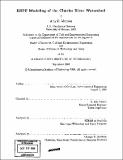| dc.contributor.advisor | E. Eric Adams. | en_US |
| dc.contributor.author | Munson, Amy D., 1971- | en_US |
| dc.coverage.spatial | n-us-ma | en_US |
| dc.date.accessioned | 2005-08-19T18:51:31Z | |
| dc.date.available | 2005-08-19T18:51:31Z | |
| dc.date.copyright | 1998 | en_US |
| dc.date.issued | 1998 | en_US |
| dc.identifier.uri | http://hdl.handle.net/1721.1/9603 | |
| dc.description | Thesis (S.M.)--Massachusetts Institute of Technology, Dept. of Civil and Environmental Engineering; and, (S.M.)--Massachusetts Institute of Technology, Technology and Policy Program, 1998. | en_US |
| dc.description | Includes bibliographical references (p. 410-414). | en_US |
| dc.description.abstract | This thesis develops a hydrological and water quality model of the Charles River Watershed in eastern Massachusetts. The model used for this project is HSPF, an EPA-sponsored continuous simulation model. Based on land use information from MassGIS, six land use types-open space/agriculture, wetland/riparian, forest, highdensity residential, low-density residential, and impervious land-were defined. The watershed was discretized into 160 reaches and subwatersheds based on physical structures and transport constraints. Stage-discharge relationships in each river reach, required by HSPF, were computed using backwater curves. Discharges of three wastewater treatment plants were added as point sources to the river. To compensate for this input of water, the groundwater pumping contributing to each treatment plant was withdrawn from the appropriate reaches. The hydrologic model in HSPF was calibrated against four streamflow gages at Milford, Dover, Wellesley, and Waltham until the highest r-squared values, lowest root mean square errors, and a reasonable surface runoff to interflow ratio were obtained. Once the hydrology was calibrated, fecal coliform was simulated in the river. Coliform sources in both wet and dry weather were identified. Postulated dry weather sources include illegal sewer connections and wastewater treatment plant discharge. Additional sources occurring during wet weather include washoff of animal feces from the watershed, combined sewer overflow discharge, increased contributions from illegal connections, and bed resuspension of coliform organisms. An inverse model was applied to measured coliform concentrations to determine coliform loads for each reach during dry weather. HSPF's build-up and washoff equations were used to calibrate the wet weather sources to the existing coliform data set. An attempt to simulate water quality-including nutrients, phytoplankton, and dissolved oxygen-was made. Because most water quality processes are temperature dependent, water temperature was first calibrated. Abundant data was available from continuous recording gages and point measurements collected by watershed volunteers. However, not enough data was available to calibrate a complete dissolved oxygen model. Parameters for instream water quality processes were adapted from a previous study done in the Charles River with QUAL2E, a steady-state model which shares many of the same water quality processes with HSPF. Nutrients were input to the river using constant concentrations based on EPA's NURP study and measurements taken in tributaries. Simulations of the available calibration data indicate that concentrations of nitrate, phosphate, and chlorophyll A in the river are reasonably simulated, but BOD concentrations are severely underestimated. Simulated dissolved oxygen agrees with point measurements quite well, although the simulated diurnal cycle has a smaller amplitude than measured and also does not capture complexity observed in the data. Further data must be collected and additional calibration performed before the water quality model can be applied to watershed management scenarios. The calibrated hydrologic model was used to test scenarios of future development in the town of Franklin. The HSPF model helped quantify reductions of streamflow that may occur if municipal pumping is increased in the upper watershed. It also helped predict changes in runoff and streamflow as forested land is converted to residential land. These brief applications indicate that this HSPF model should be a good tool for helping direct and evaluate future watershed policy. | en_US |
| dc.description.statementofresponsibility | by Amy D. Munson. | en_US |
| dc.format.extent | 414 p. | en_US |
| dc.format.extent | 27063656 bytes | |
| dc.format.extent | 27063410 bytes | |
| dc.format.mimetype | application/pdf | |
| dc.format.mimetype | application/pdf | |
| dc.language.iso | eng | en_US |
| dc.publisher | Massachusetts Institute of Technology | en_US |
| dc.rights | M.I.T. theses are protected by copyright. They may be viewed from this source for any purpose, but reproduction or distribution in any format is prohibited without written permission. See provided URL for inquiries about permission. | en_US |
| dc.rights.uri | http://dspace.mit.edu/handle/1721.1/7582 | |
| dc.subject | Civil and Environmental Engineering | en_US |
| dc.subject | Technology and Policy Program | en_US |
| dc.title | HSPF modeling of the Charles River Watershed | en_US |
| dc.title.alternative | Hydrologic Simulation Program-FORTRAN modeling of the Charles River Watershed | en_US |
| dc.type | Thesis | en_US |
| dc.description.degree | S.M. | en_US |
| dc.contributor.department | Massachusetts Institute of Technology. Department of Civil and Environmental Engineering | en_US |
| dc.contributor.department | Technology and Policy Program | en_US |
| dc.identifier.oclc | 42242438 | en_US |
